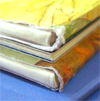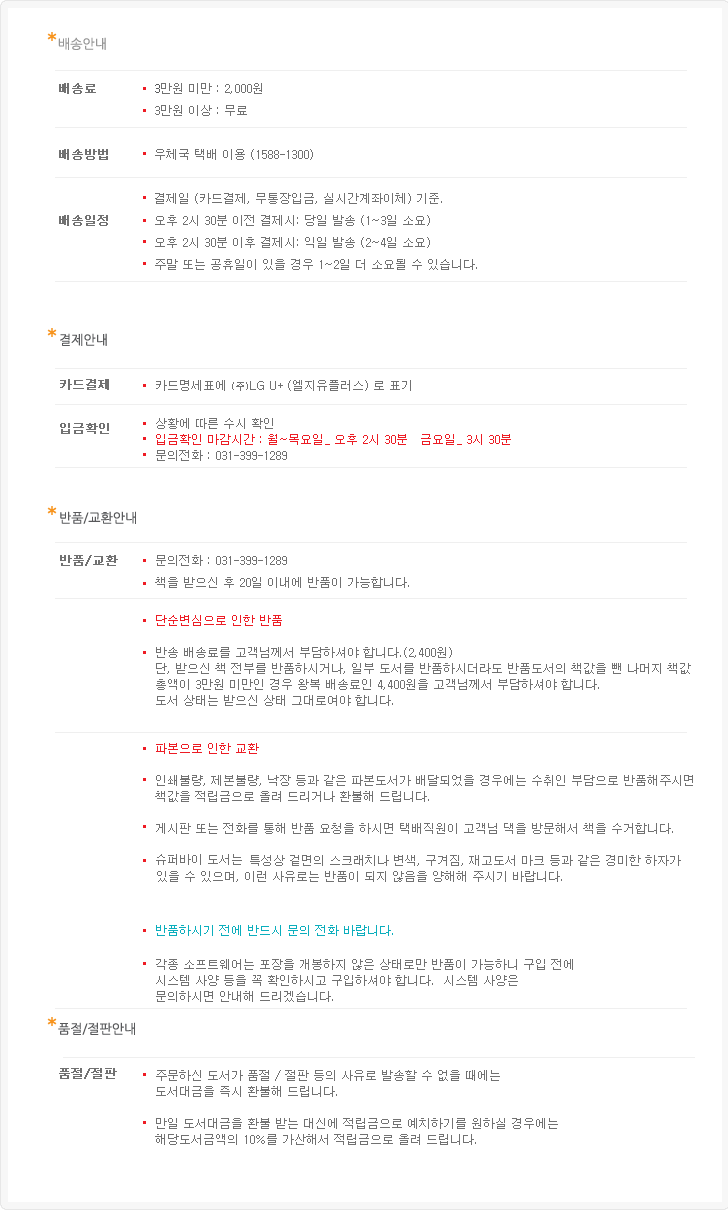|
|
|
|
|
|
|

| 최근 이 책을 구매하신 다른 회원의 책장 |
|
 |
|
|
|
[ 책 소개 ]
* Caldecott Honor 수상작
* ALA Notable Children's Books
* Boston Globe/Horn Book Award 수상작
깊이있는 내용과 환상적인 그림들이 가득한 피터 시스의 대표작 중 하나입니다. 국내에는 "티베트"라는 제목으로 번역서가 출간되었습니다.
이 책은 작가인 Peter Sis의 가족사와 어릴 적 추억을 바탕으로 만들어진 책입니다. 고향이 체코의 프라하인 Peter Sis는 50년대 중반, 체코가 공산국가였을 때, 영화제작자였던 아버지가 중국에 영화기술을 가르치기 위해 갔다가 티벳에서 실종되어서 수년동안 소식이 끊긴 적이 있습니다. 수년 후 집에 돌아온 아버지는 빨간 상자를 매우 소중하게 여기시면서 어린 Peter Sis에게는 손도 대지 못하게 했습니다. 세월이 흐른 어느날 Peter Sis에게 아버지로부터 한 통의 편지가 전달되고, 그 편지에 적힌대로 피터시스는 프라하에 있는 옛날 어릴 적 살던 집의 다락방 서재에서 빨간 상자를 열어봅니다. 그 안에는 아버지가 50년대 티벳에서 행방불명이 되었을 때 겪었던 신비로운 이야기들이 적혀있는 일기장이 있었습니다. 이 일기장을 토대로 Peter Sis는 아버지의 과거 티벳 여정을 거슬러 올라가면서 티벳의 경치, 풍습, 종교, 문화 등에 관한 환상적인 그림과 이야기의 파노라마를 펼쳐 나갑니다.
감탄사가 나올 만큼 아름다운 세밀화 그림과 함께 티베트의 놀랍고도 신비한 이야기 속으로 환상 여행을 떠나 보세요.
튼튼한 | 닫기x |  What is 하드커버? What is 하드커버?
양장본이라고도 불리우며, 표지가 단단한 판지로 만들어진 책입니다.
판지를 천이나 가죽으로 감싸기도 합니다. 책의 속지는 일반적으로 중성처리된 종이(Acid-free paper)를 사용해서 잘 변질이 되지 않기 때문에 오랫동안 보관하기에 적합합니다. 이 종류의 책은 더스트 재킷, 또는 더스트 커버로 불리는 표지덮개가 함께 있는 경우가 많습니다. 간혹 내부 속지가 콩기름 코팅이 된 경우 고약한 냄새가 나는 책도 있습니다.
|
[ 서지 정보 ]
Edition: Hardcover, 60 pages
ISBN-10: 0374375526
ISBN-13: 978-0374375522
책 크기 : 28.7cm x 27.7cm
[ 영문 서평 ]
The New York Times, Richard Bernstein
These arresting and luscious drawings so dominate the book that you almost fail to notice the text that they accompany, but there is a text, almost an incantation, whose motif is a child's wide-eyed rumination on the magical and strange stories of his father.... a charming book and a visually beautiful one...
Booklist
Sis is best known as the illustrator of such notable children's books as Starry Messenger (1996), a Caldecott Honor Book. This book, too, has much that will appeal to the young reader, but its mix of biography, magic realism, and intricate artwork exudes a sophistication that takes it beyond the borders of Sis' usual audience. When Sis opens the red lacquered box that has sat on his father's table for decades, he finds the diary his father kept when he was lost in Tibet in the mid-1950s. The text replicates the diary's spidery handwriting, while the illustrations depict elaborate mazes and mandalas, along with dreamlike spreads that are filled with fragmented details of the father's and son's lives. As the story of the elder Sis' journey into the heart of Tibet unfolds, with its magical messengers, Yeti and a Boy-God-King, Sis begins to come to terms with what the loss of his father for that time meant to him, then and always. This is not a book that's easy to describe. Each element folds into the other and blends, then changing shape, like a kaleidoscope. Impeccably designed and beautifully made, the book has a dreamlike quality that will keep readers of many ages coming back to find more in its pages.
From Publishers Weekly
In this visually enticing, magically appealing, oversized volume, Czechoslovakian-born illustrator Sis applies his considerable gifts to painting a spellbinding portrait of his father's experiences in Tibet, where he was sent in the 1950s to instruct the Chinese in documentary filmmaking. Vladimir Sis was actually drafted by the Chinese government to record the construction of a highway from China into Tibet; he was to be gone more than two years, unable to communicate with his family. During that time, China invaded the neighboring country, and Sis senior witnessed events he dared not describe even after he returned home, except through "magical stories" he related to his son. The diary he kept during his sojourn in Tibet was locked in a red box, which his son only saw for the first time in 1994, when he received a cryptic message from his father: "The diary is now yours." Here Sis re-creates a facsimile of the diary with excerpts handwritten upon parchment-like backgrounds on double-page spreads brimming with pencil sketches of the events described (e.g., "The road looks like a cut into a beautiful cake"). He then magnifies the more uncanny aspects of the journal via the tales told to him by his father, recollected from childhood, which are printed on the succeeding spread. One entry describes a boy wearing bells who tracks down the filmmaker in the middle of nowhere to deliver a letter from his family; Sis then follows with "The Jingle-Bell Boy," festooning the account with a trail of rhododendron-leaf markings that lead his father ultimately to the Dalai Lama. The guileless prose of both father and son makes Sis's juxtaposition of the journal records with his own childhood memories all the more poignant. The luminous colors of the artwork, the panoramas of Tibetan topography and the meticulous intermingling of captivating details and the mystical aspects of Tibetan culture make this an extraordinary volume that will appeal to readers of all ages. Author tour.
From School Library Journal
Through personal memories, old tales, and intriguing pictures, Sis opens a door to the little-known land and religion of Tibet. There is a room, a study, in a house in Prague where a red box waits to be opened. It holds a diary of a long ago journey to Tibet made by the author's filmmaker father, sent to record the building of the first road from Communist China into the high mountains of Tibet. The room appears again and again, suffused with the colors of memory. Throughout the book are small sketches and large landscapes, and handwritten diary pages on yellowed sheets with the texture of parchment. Similar in structure and art style to Sis's The Three Golden Keys (Doubleday, 1994), this book is more solidly grounded in the reality of an adventurous journey to central Asia. Then, like a nest of boxes, it reveals layers of memory, tales of Tibet and, finally, references to the present era of political oppression and the hopes that rest on the singular figure of the Dalai Lama. Most intriguing are the eight full-page illustrations inspired by circular, symmetrical patterns and detailed symbols of the Tibetan wheel of life, creatively adapted to the text. Who will venture to study and decipher this artful book with its postmodern structure, its mysterious figures, and its interweaving of past and future? Adults will see the book as a way to introduce children to the geography, culture, and religion of Tibet. Attentive young people will be drawn to puzzle out the meaning of the stories and pictures. Art-conscious readers of all ages will appreciate the author's groundbreaking, creative use of the pictur| 닫기x |  What is What is | 닫기x |  What is e-book? What is e-book?
전자책(electronic book)이라고도 불리우며, 책의 내용을 종이가 아닌 컴퓨터 모니터나 핸드폰의 화면을 통해 읽을 수 있습니다.
|
전자책(electronic book)이라고도 불리우며, 책의 내용을 종이가 아닌 컴퓨터 모니터나 핸드폰의 화면을 통해 읽을 수 있습니다.
|
| 닫기x |  What is e-book? What is e-book?
전자책(electronic book)이라고도 불리우며, 책의 내용을 종이가 아닌 컴퓨터 모니터나 핸드폰의 화면을 통해 읽을 수 있습니다.
|
From Library Journal
The noted illustrator/storyteller recounts his father's two years trapped in Tibet. |
|
|
|
|
 |
제품상제정보 배송/반품/교환 안내 |
|
|
|
Super Buy 도서는 미국 출판사의 재고도서(Remainder Book), 초과출간도서(Excess Inventory), 할인도서(Bargain Books)
등을 직수입해서 정가의 55%~80%를 할인한 가격에 판매하는 제품입니다.
Super Buy 책의 품질은 거의 새 책과 같은
수준이지만, 간혹 커버의 스크래치나 접힘과 같은 하자나, 책 하단의 재고도서 마크가 있을 수 있습니다.
저렴하게 판매하는 Super Buy 제품의 특성상 반품이 되지 않습니다만, 파본인 경우에는 착불로 반품하시면 책값을
환불해드리거나 적립금으로 올려드립니다. (반품 전에 연락 요망)
하프프라이스북에서는 중고도서(second hand book)를 취급하지 않습니다.
|
|
 총 5건의 독자서평이 있습니다. 총 5건의 독자서평이 있습니다. |
|
 티벳..환상의 그 이름 티벳..환상의 그 이름 |
Tibet : Through the Red Box
이 책은 유아를 위한 책이 아니며, 글도 많고 내용도 어렵습니다
회상하는 형식의 부친의 자서전 성격을 띄면서도
초현실주의적인 내용이 신비하기조차 합니다.
칼테콧상 수상..

Tibet : Through the Red Box
이 책은 유아를 위한 책이 아니며, 글도 많고 내용도 어렵습니다
회상하는 형식의 부친의 자서전 성격을 띄면서도
초현실주의적인 내용이 신비하기조차 합니다.
칼테콧상 수상작이니만큼, 글,그림은 기대하셔도 좋습니다
책도 하프에서 올린 이미지에는 안나와있지만, 책장을 넘기다보면
커다란 불상을 동그랗게 감싼 작은 불상의 동그란 이미지라던지..
그리고 그 원을 다시 액자처럼 둘러친 테두리라던지..하는 등등...
곳곳에서 이국적인 느낌과 작가의 티벳에 대한 이해를 엿보는 듯 하구요
티벳 문화에 대한 신비한 글과 그림을 통해 꿈꾸는듯한 환상여행이 가능하답니다.
이렇게 벼룩시장용으로 나오지 않는다면 가격이 일단 비싸서
감히 구입하기 어려운 책이 될 것입니다.
이런 책은 이렇게 하드커버에 지질이 좋은 걸로 보는게 좋아요
책에 있어서 매니아 기질이 있는 분이라면 절대 놓치지 마세요^^
국내에서도 쉽게 구하기 어려운 책이예요
이 책과 함께 문학동네에서 간행된 바 있는 "티벳 사자의 서" 같은 책도
같이 읽으시면 티벳 문화에 대한 이해가 깊으실 것입니다
"티벳 사자의 서는’ '이집트 사자의 서'와 더불어
죽음에 관한 인류의 가장 뛰어난 기록으로 평가되고 있습니다.
 |
평점      | 조회 (292) | 추천 (38) | 문지윤 2002/07/16 | 조회 (292) | 추천 (38) | 문지윤 2002/07/16 |
| |
 소장이라도 하고 싶은 책! 소장이라도 하고 싶은 책! |
이 책, 구경만 했어요. 어려워 보이긴 하지만 우선 소장이라도 하고 싶은 책이예요.
그림책 치고 굉장히 품위 있는 책이지요. 겉표지가 기름종이로 되어 있거든요.
정말 보고 싶은데 하프에서 몇 년전에 잠깐 반..

이 책, 구경만 했어요. 어려워 보이긴 하지만 우선 소장이라도 하고 싶은 책이예요.
그림책 치고 굉장히 품위 있는 책이지요. 겉표지가 기름종이로 되어 있거든요.
정말 보고 싶은데 하프에서 몇 년전에 잠깐 반짝 들여오시고는 영 들여오질 않으시네요.
계속 기다리고 있는 데 ... 보고 싶은데 빨리 들여와 주세요.
Peter Sis가 그린 그림책들은 느낌이 다른 그림책들과는 정말 다릅니다. 깊이가 느껴지지요.
그래서 아이와 어른이 함께 볼 수 있는 책이지요. 아이들은 그림만 보고, 어른들은 영어도 읽고.
영어문장도 만만치 않은데다가 글자를 읽기도 쉽지 않지요.
저는 구하지도 못한 이 책 덕분에 티벳만 나오면 눈과 귀가 번쩍 뜨인답니다.
빨리 구하고 싶은 책입니다.
 |
평점      | 조회 (303) | 추천 (33) | 김상옥 2004/04/20 | 조회 (303) | 추천 (33) | 김상옥 2004/04/20 |
| |
 한글판과는 다른 멋이 있어요. 한글판과는 다른 멋이 있어요. |
피터 시스라는 작가를 개인적으로 좋아하는 편이라서 사실 그의 글을 좋아하는 건 아니고, 독특한 그림을 좋아하는 것이긴 하지만 여러 권 가지고 있는데 티베트라는 번역본을 도서관에서 먼저 봤어요.
그런데 이..

피터 시스라는 작가를 개인적으로 좋아하는 편이라서 사실 그의 글을 좋아하는 건 아니고, 독특한 그림을 좋아하는 것이긴 하지만 여러 권 가지고 있는데 티베트라는 번역본을 도서관에서 먼저 봤어요.
그런데 이번에 원서로 구입해 보니 더스트 커버가 참 독특하네요. 기름종이라고 해야 하나요? 그 위에 옅은 금색으로 그려진 옛 지도의 느낌이 독특해서 커버까지 잘 보관해야 할 것 같아요.
글은 좀 어렵고, 특히나 필기체처럼 쓰인 글은 눈에 가독성이 떨어지긴 합니다.
저처럼 소장하고 싶은 분들께는 좋을 것 같아요.
 |
평점      | 조회 (109) | 추천 (25) | 박미숙 2010/12/25 | 조회 (109) | 추천 (25) | 박미숙 2010/12/25 |
|  |
|
|
|
|
|
|
 - 등록된 128,146건의 서평이 있습니다. - 등록된 128,146건의 서평이 있습니다.
| 더보기 
|
|
|
|
|
|
|
 |
|
|
|
|
|
|